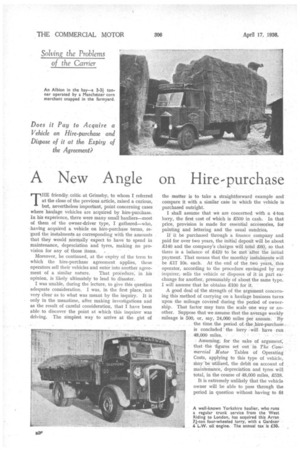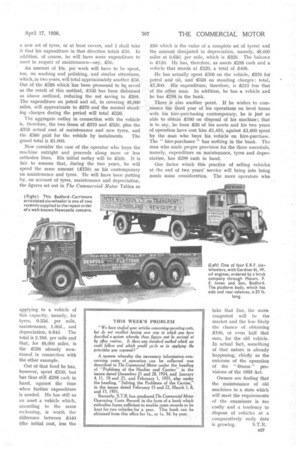A New Angle on Hire-purchase T ..HE friendly critic at Grimsby,
Page 40

Page 41

If you've noticed an error in this article please click here to report it so we can fix it.
to whom I referred at the close of the previous article, raised a curious,
• but, nevertheless important, point concerning cases where haulage vehicles are acquired by hire-purchase. In his experience, there were many small hauliers—most of them of the owner-driver type. I gathered—who, • having acquired a vehicle on hire-purchase terms, regard the instalments as corresponding with the amounts that they would normally expect to have to spend in maintenance, depreciation and tyres, making no pro vision for any of those items. .
Moreover, he continued, at the expiry of the term to which the hire-purchase agreement applies, these operators sell their vehicles and enter into another agree
ment of a similar nature. That proCedure, in his opinion, is likely ultimately to lead to disaster.
I was unable, during the lecture, to give this question adequate consideration, I was, in the first place, not very clear as to what was meant by the inquiry. It is only in the meantime, after making investigations and as the result of careful consideration, that I have been able to discover the point at •which this inquirer was driving. The simplest way to arrive at the gist of the matter is to take a straightforward example and compare it with a similar case in which the vehicle is purchased outright.
I shall assume that we are concerned with a 4-ton lorry, the first cost of which is £500 in cash. In that price, provision is made for essential aCcessories, for painting and lettering and the usual sundries.
If it be purchased through a finance company and paid for over two years, the initial deposit will be about £140 and the company's charges will total £60, so that there is a balance of £420 to be met after the initial payment. That means that the monthly instalments will be £17 10s. each. At the end of the two years, this operator, according to the procedure envisaged by my inquirer, sells the vehicle or disposes of it in part exchange for another, presumably of about the same type. I will assume that he obtains £100 for it.
A good deal of the strength of the argument concern ing this method of carrying on a haulage business turns upon the mileage covered during the period of owner ship. That factor may turn the scale one way or another. Suppose that we assume that the average weekly mileage is 500, or, say, 24,000 miles per annum. By the time. the period of the hire-purchase is concluded• the lorry will have run 48,000 miles.
Assuming, for the sake of argument; that the figures set out in The Commercial Motor Tables of Operating Costs, applying to this type of vehicle, may-be.utilized, the debit on account of maintenance, depreciation and tyres will total, in the course of 48,000 miles, £538.
It is extremely unlikely that the vehicle owner will be able to pass through the period in question without having to fit a new set of tyres, or at least covers, and I shall take it that his expenditure in that direction totals £50. In addition, of course, he will have some expenditure to meet in respect of maintenance—say, 250.
An amount of 10s, per week will have to be spent, too, on washing and polishing, and similar attentions, which, in two years, will total approximately another £50. Out of the 2538which has been presumed to be. saved as the result of this method, zuo has been disbursed as above outlined, reducing the net saving to £388. The expenditure on petrol and oil, in covering 48,000 miles, will approximate to 2370 and the normal standing charges during the period will total £520;
The aggregate outlay in connection with the vehicle is, therefore, the two items of 2370 and 2520, plus the £150 actual cost of maintenance and new tyres, and the 2560 paid for the vehicle by instalments. The grand total is £1,600.
Now consider the case of the operator who buys the machine outright and proceeds along more or less orthodox lines. His initial outlay will be 2500. It is fair to assume that, during the two years, he will spend the same amount (2150) as his contemporary on maintenance and tyres. He will have been putting by, on account of tyres, maintenance and depreciation, the figures set out in The Commercial Motor Tables as
applying to a vehicle of this capacity, namely, for tyres, 0.55d. per mile, maintenance, 1.00d., and depreciation, 0.644. The total is 2.19d. per mile and that, for 48,000 miles, is the 2538 already mentioned in connection with the other example.
Out of that fund he has, however, spent £150, but has thus still 2288 cash in hand, against the time when further expenditure is needed. He has still as an asset a vehicle which, according to the same reckoning, is worth the difference between £440 (the initial cost, less the 260 which is the value of a complete set of tyres) and the amount dissipated in depreciation, namely, 48,000 miles at 0.644. per mile, which is £320. The balance is 2120. He has, therefore, as assets 2288 cash and a vehicle that stands at 2120, a total of £408.
He has actually spent £500 on the vehicle, £370 for petrol and oil, and £520 on standing charges; total, 21,300. His expenditure, therefore, is 2210 less that of the other man. In addition, he has a vehicle and he has 288in the bank.
There is also another point. If he wishes to commence the third year of his operations on level terms with his hire-purchasing contemporary, he is just as able to obtain 4100 on disposal of his machine; that is to say, he loses £20 of his assets and his two years of operation have cost him £1,410, against 21,600 spent by the man who buys his vehicle on hire-purchase. The " hire-purchaser" has nothing in the bank. The man who made proper provision for the three essentials, namely, expenditure on maintenance, tyres and depreciation, has £288 cash in hand.
One factor which this practice of selling vehicles at the end of two years' service will bring into being needs some consideration. The more operators who take that fine, the more congested will be the market and the less likely the chance of obtaining £100, or even half that sum, for the old vehicle. In actual fact, something of that nature is already happening, chiefly as the outcome of the operation of the " fitness " provisions of the 1933 Act.
Owners are finding that the maintenance of old machines in a state which will meet the requirements of the examiners is too costly and a tendency to -dispose of vehicles at a comparatively early date is growing. S.T.R.






























































































